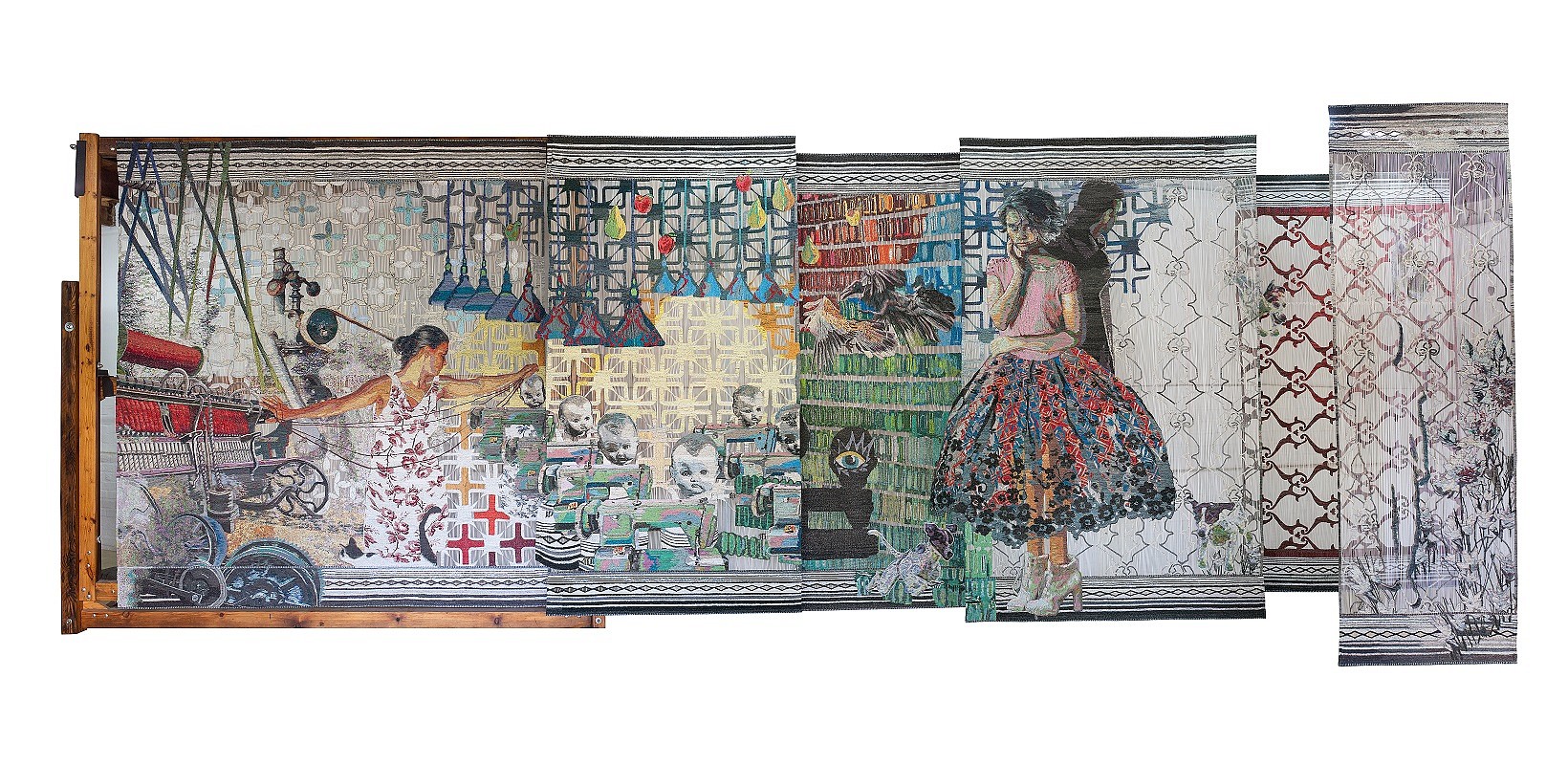PRESS RELEASE

TAMLIN BLAKE: Tied by Time
Nov 23, 2019 – Jan 13, 2020
Tamlin Blake
Tied by Time
Text by Olga Speakes
Tamlin Blake’s monumental tapestry installation is akin to a Renaissance fresco in its magnitude of scale, the sweeping drama of its thematic conception and the brilliance of its detail. Through a series of five scenes spread over six panels, the first of which is suspended from a giant wooden loom, the artist is taking us on a historical journey that spans several hundred years while at the same time managing to weave a personal story that draws the viewer into the private world of her imagination, personal histories and concerns that also speak to the wider anxieties, hopes and fears of our times.
The project that took the artist four years to complete, was set up as an enquiry into the fourth industrial revolution, a phenomenon characterized by much media and political hype and little common understanding of either its scope or its potential impact on our everyday lives.
From panel to panel, the artist invites us to follow her on an epic journey that connects the past, the present and the future. The starting point for the journey into the past, and the first tapestry in the installation, takes the viewer to the symbolic historical events of the eighteenth century when the modernization of the textile industry through use of steam and other technological innovations lead to the first industrial revolution. It altered both the physical landscape and the social fabric of the human world ushering in, along with economic gains, social alienation and loss of livelihoods, destruction of the countryside and loss of family ties. Her second panel continues to reference the history of industrial progress with the invention of electricity, i.e. the second industrial revolution, and then, the introduction of automation and conveyor belt production. The next phase of our society’s development, the computer age and the digital revolution associated with it, is referenced in the next panel with its ambiguous, library-like wall that reveals its digital make up on closer inspection.
Walking from panel to panel following the thread of the story, the viewer embarks on an actual journey through the installation that is set up as a path where a new chapter opens up as we move along. On the one hand, Blake offers us a bird’s eye view of History and this view comes to us with the advantage of knowing both the gains of industrial progress and its costs; personal, social and environmental. On the other hand, this view is deeply personal to the artist and it becomes personal to us as we physically make our way through the work.
Addressing the personal, intimate, human aspects of history is central to Blake’s practice. The artist weaves herself into the sweeping story of progress on several levels. Her own questioning presence is implied through the image of the protagonist in the first tapestry. In the original mythological story the heroine Penelope is able to hold the relentless advance of unwanted suitors (and the development of history) at bay by weaving her own tapestry by day and unpicking whatever progress she had made, by night.
The beautiful young woman holding a thread in the first panel references Penelope as the un-raveller of history and at the same time appears to us as the artist herself, in her double role of the story teller and the subject of history which no one can escape. She seems to question the advance of technology and sees it as both enriching and threatening our world consigning whole industries, practices and ways of life to the past. The use of tapestry, hand woven by the artist and her studio assistants from the thread that is hand spun and hand dyed using cut up newspapers, sets up the tension between the familiar celebratory accounts of progress and technological development and a sense of nostalgia, mental disquiet and loss.
These are not just premonitions based on the fear of the unknown, although those anxieties are also present in the work, especially in the fourth panel, the most personal and lyrical of them all, that references artists’ own children whose future along with our own, which we are trying to figure out, in this intricately complex work. The unsettled feeling that Blake creates disrupts the neat flow of history as progress. The odd construction of spaces in the first three panels and uncanny details like the baby-doll heads that seem marching and gazing fixedly at us, the clashing decorative patterns of the background that reference the Arts and Crafts aesthetic of the late nineteenth century, which also rebelled against technological progress, evoke a sense of the impending danger if not catastrophe. It is the catastrophe that we ourselves may have contributed to in our relentless drive to speed up history in the service of our insatiable desires.
The sense of transience and fragility of our existence is another key theme that occupies the artist and that is evoked in her unique technique, where shreds of newspapers, which hold innumerable human stories and become obsolete the moment they come out, are dyed and spun into tapestry thread. The uncertainty of the future, which is encoded in the figures of the children in the fourth and fifth panels, youthful and vulnerable, appears balanced by that of the weaver, Penelope, in the first. Their bond and her protective gaze offer us hope in the face of this uncertainty. For as long as Penelope keeps spinning her thread and weaving her tapestry – for as long as the artist is able to keep telling her story through her making – the hope will be kept alive, our world will avoid a fatal collision with its own insatiable appetite for growth and progress, our future will be saved even if it means that some of our cherished beliefs in technology and progress have to be unpicked one thread at a time.



